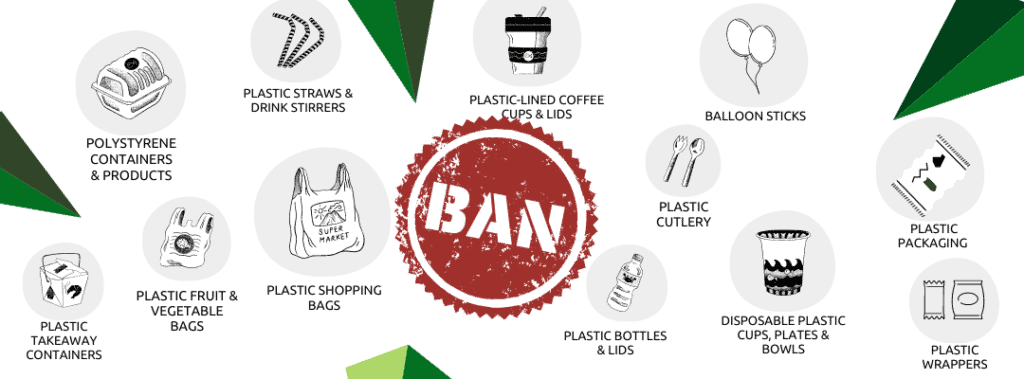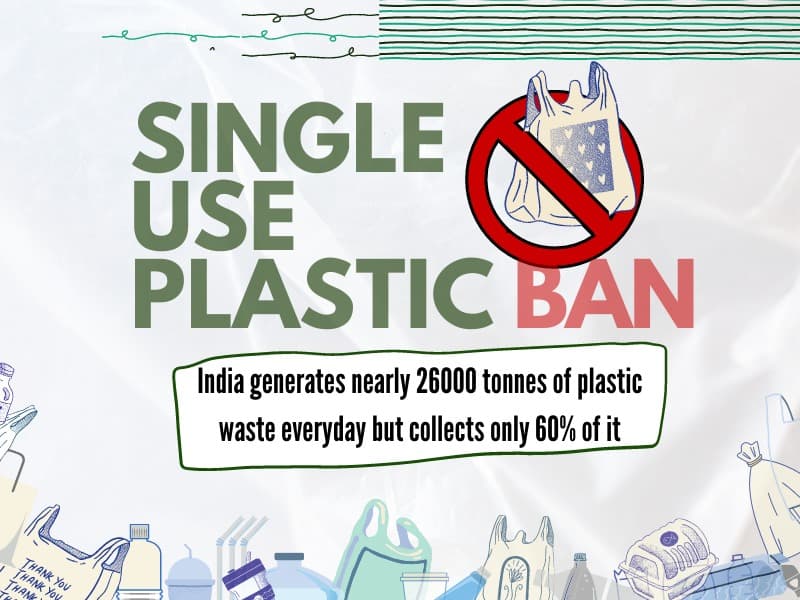Approximately 43% plastics manufactured in India are Single-Use

Single-use plastics are products made from petrochemical compounds that are meant to be disposed of immediately after use. In simpler terms, they are plastic products used for a single application only.
These Single-Use Plastics are lightweight and have high polluting potential since they decompose over several hundred years. Over the past several years, these plastics have infiltrated and polluted almost all ecosystems.
History of Plastic
The journey of plastic began in the early 20th century with the invention of Bakelite in 1907, which was the first fully synthetic plastic. Plastics quickly gained popularity due to their versatility, durability, and low cost. By the 1950s, mass production of plastic materials had begun, revolutionising industries such as packaging, construction, healthcare, and electronics.
However, the 1970s and 1980s saw the rise of single-use plastic items due to their convenience and disposability. As demand soared, so did the environmental consequences. Today, plastic is both a symbol of modern innovation and an emblem of global environmental concern.
About Single-Use Plastic
Single-Use Plastics (SUPs) are plastic products designed to be used once and then discarded. These include plastic straws, stirrers, cutlery, plates, bags, and packaging films. While they may seem convenient, their short lifespan and non-biodegradable nature make them one of the most damaging forms of plastic pollution.
Due to their lightweight composition, single-use plastics often escape proper waste disposal systems, clogging drains, polluting oceans, and harming wildlife. Their production relies heavily on fossil fuels, further contributing to environmental degradation.
The Plastic Problem
Despite their widespread use, plastics, especially Single-Use Plastics have become a massive global environmental challenge. Globally, millions of tonnes of plastic waste are generated each year, with a significant portion ending up in landfills, oceans, and other natural habitats. Below are key issues caused by plastic pollution:
Environmental Impact
Non-biodegradable Nature: Plastics can decompose 500–1000 years, leading to long-term pollution.
Microplastic Pollution: Broken-down plastic particles have contaminated oceans, soil, air, and human organs.
Marine Threat: Over 100,000 marine animals die each year due to ingestion or entanglement in plastic debris.
Land Degradation: Plastics reduce soil fertility and interfere with natural drainage systems, causing floods.
Waste Management Issues
Overflowing Landfills: A significant percentage of municipal solid waste is plastic, leading to unmanageable landfills.
Low Recycling Rates: Globally, less than 10% of plastic waste is recycled efficiently.
Mixed Waste Challenge: Plastics often contaminate other waste streams, making segregation and treatment difficult.
Air and Water Pollution
Toxic Emissions: Burning plastic releases harmful gases like dioxins and furans, which are carcinogenic.
Water Contamination: Plastics clog waterways and release toxic additives that seep into freshwater sources.
Health Hazards
Chemical Leaching: Plastics contain chemicals such as BPA, phthalates, and flame retardants, which may disrupt hormones and cause other health issues.
Food Chain Contamination: Microplastics have been found in fish, salt, and bottled water, posing risks to human health.
Airborne Particles: Inhalation of microplastics is becoming a concern, especially in urban areas.
Climate Change Contribution
Fossil Fuel Dependency: Over 99% of plastics are derived from chemicals sourced from fossil fuels.
Carbon Emissions: Plastic production and incineration contribute to greenhouse gas emissions, accelerating climate change.
Regulatory Guidelines to Eliminate Single-Use Plastics
To address the rising issues of plastic pollution from Single-Use Plastics, the Ministry of Environment, Forest, and Climate Change has proposed a framework to phase them out from production and consumption systematically. This framework has been made available as part of the Plastic Waste Management Rules and their respective Amendments.
The guidelines highlight a step-wise format within a time frame to phase out the production and consumption of Single-Use Plastics. Some of the key pointers can be listed below:
For Plastic Carry Bags
The permissible thickness of carry bags is to be increased
– From 50 microns to 75 microns with effect from 30th September 2021
– From 75 microns to 120 microns with effect from 31 December 2022
For Non-Woven Plastic Bags
The ban will also be imposed on non-woven plastic bags less than 60 GSM, with enforcement from 30th September 2021
For Compostable Plastic Bags
– Carry bags and commodities made out of compostable plastics to conform to industrial specifications curated for compostable plastics.
– Manufacturers of compostable plastics will be required to obtain a certificate from CPCB.
– Details such as the Name and Certificate Number of the producer/manufacturer to be provided if the carry bags are made from compostable plastics
For Commodities
With effect from 1 July 2022, the manufacture, import, stocking, distribution, sale, and use of Single-Use Plastics, including Polystyrene and expanded polystyrene, shall be prohibited.
Health Risks of Plastics
Plastics pose a serious health risk to humans, not just because of the physical waste. Microplastics can enter our bodies through food, water, and even air. Many plastics contain endocrine-disrupting chemicals that interfere with hormonal balance. These substances are linked to health conditions like hormonal imbalances, fertility problems, developmental issues, and certain cancers. Plastics contain harmful chemicals like phthalates and endocrine disruptors that can affect human health.
Environmental Pollution from Single-Use Plastics
Single-use plastics may seem convenient, but they leave a lasting negative impact on the planet. While we often see plastic waste on the streets, the real damage is in water bodies. Plastic items discarded on land usually get swept into rivers and oceans through rain or stormwater drains.
Single-use plastics often end up in rivers and oceans, harming marine life. Just 10 rivers are responsible for 93% of the plastics flowing into the sea. Turtles, whales, and seabirds commonly ingest plastic; by 2050, oceans could contain more plastic than fish by weight.
Ban and Penalty on Single-Use Plastics
The CPCB and SPCBs are tasked with implementing the single-use plastic ban. Petrochemical companies are barred from supplying raw materials to banned product manufacturers, and violators’ licenses can be revoked or modified under environmental laws.
Local bodies must ensure that new commercial licences prohibit SUPs and that existing ones can be cancelled for non-compliance. CPCB has certified over 200 compostable plastic producers, and BIS has approved standards for biodegradable plastics.
Under the Environment Protection Act, 1986, offenders face:
– Up to 5 years in jail
– Fines up to ₹1 lakh
– Environmental compensation charges
FAQs
What is the most common single-use plastic?
Plastic bottles, caps, food wrappers, grocery bags, and straws are among the most common single-use plastics polluting the environment.
Can single-use plastics be recycled?
Depending on the material, some single-use plastics are recyclable. However, many are not correctly processed and end up in landfills or oceans.
How do microplastics affect soil and water?
Microplastics release harmful chemicals into soil and water, contaminating ecosystems and posing risks to wildlife and human health.
How much plastic do humans consume?
Studies suggest that the average person may ingest about 5 grams of microplastics weekly..

